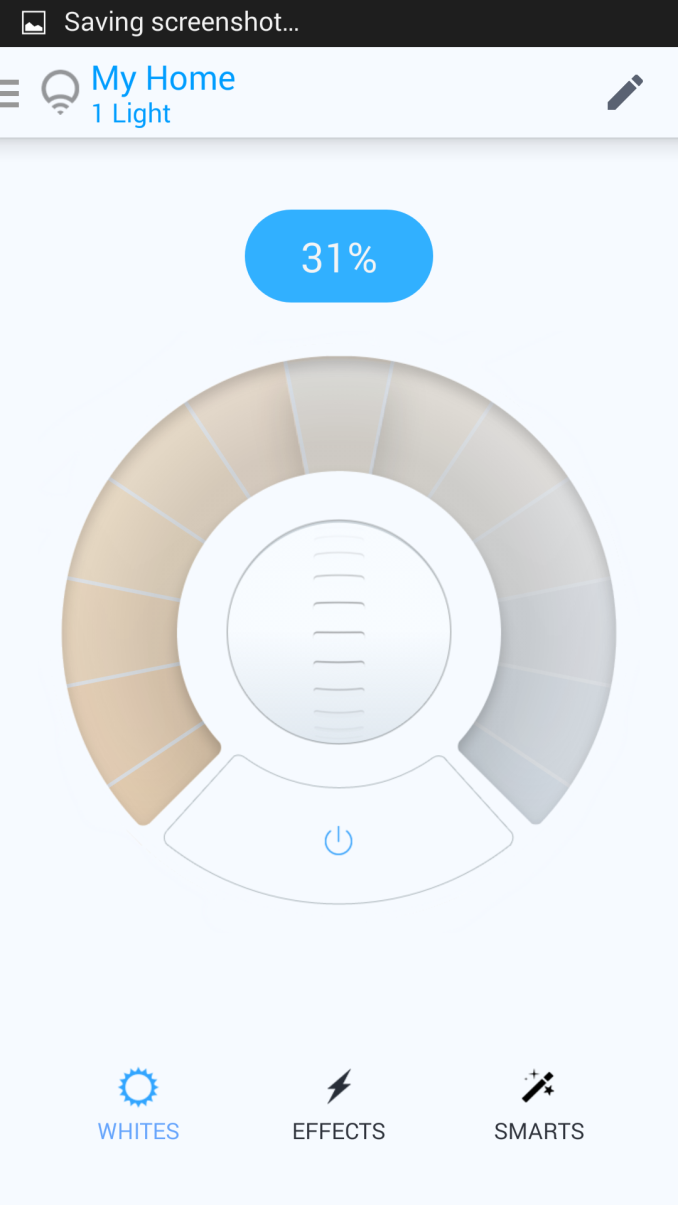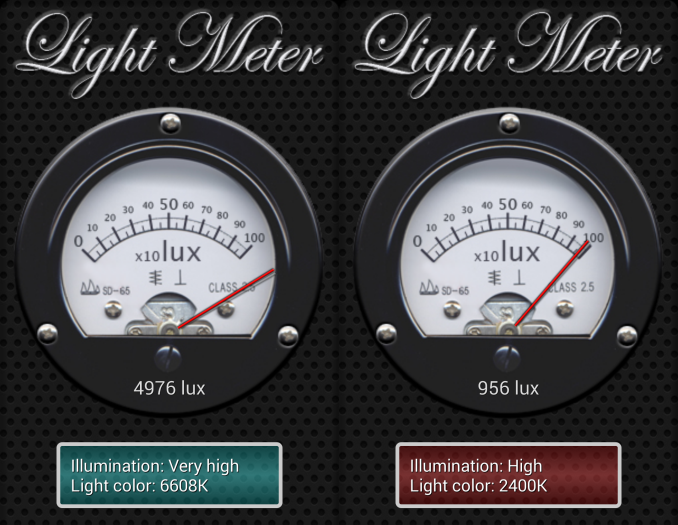LIFX White 800 Smart Bulb Review
by Ganesh T S on June 12, 2015 9:55 AM EST- Posted in
- Home Automation
- Wi-Fi
- Qualcomm Atheros
- LIFX
Setup, Usage and APIs
The setup process for the LIFX White 800 is similar to most other IoT devices. The unit boots up with its own SSID. A mobile device (iOS or Android) with the LIFX app pre-installed is made to connect to it. A LIFX account is associated with the device. It enables control over Internet with communication via LIFX's servers.
Dimming is achieved via the core thumb-wheel in the app's home page. Color temperature can be tuned using the dial around it.
Many of the other app features such as themes are applicable to the multi-colored light bulbs. However, the scheduling feature works well with the White 800.
On the whole, the app is straightforward and easy to use.
We measured color temperature of the light bulb's out with a Samsung Galaxy S4 using a Light Meter app. The color temperature dial in the LIFX app was set to the two extreme temperature points for the screenshots below.
The color temperature measured as per the specifications and was obviously evident to the naked eye.
LIFX has been quite popular with power users. The communication protocol was reverse engineered, and there are multiple open source projects based on them. lifx-http, lifxjs and lifx-java are examples. Firmware v2.00 messed up many of these apps. However, it also brought along support for the official HTTP APIs. The APIs are a very good starting point and allow simple apps, but, unfortunately relies on the LIFX's web servers being up and the user's Internet connection being active (it is cloud-only). Recently, the official LAN-only documentation was updated. Hopefully, local HTTP APIs are made available soon - either officially from LIFX or via third-party developers.
Initially, LIFX didn't appear power-user friendly after the launch of v2.00 of the firmware, but things are slowly getting better with the publishing of the LAN protocol. The main item in our wishlist with respect to usage / APIs is a web interface for the bulb - the ability to control the light temperature and brightness using a web browser. This interface could also double up as an official 'mobile app' for platforms such as Windows Mobile.
























55 Comments
View All Comments
pixelstuff - Friday, June 12, 2015 - link
By your comment it sounds like you think "observe" means to visually see something, but the dictionary definition of observe is simply to "notice or perceive (something) and register it as being significant."Zak - Friday, June 12, 2015 - link
The Internet of Things (IoT) revolution? What revolution? It's a solution that needs a problem first, far from a revolution.zepi - Friday, June 12, 2015 - link
The kind of revolution that a lot of people don't really notice it before they are napping on the sofa and telling stories to their grand children.And even then they only notice it from the way the their kid's eyes lighting up from excitement and disbelief when you tell that back then you had to drive your own car, switch on the lights from a physical switch and get groceries yourself. And that no, your fridge & cupboard really didn't used to get filled automatically with your favourite breakfast cereals & milk by little flying drones...
And that your clothes didn't measure your blood pressure and people actually didn't get always get instantly help for heart attack or stroke, because their clothes didn't measure their health level and weren't connected.
etc.
Thing that seem unnecessary and not really revolutionary now, but that you'll be missing once you are used to them.
Ratman6161 - Friday, June 12, 2015 - link
Also explain to them how we didn't have to worry about the security of our light bulbs or software updates for them :)Impulses - Saturday, June 13, 2015 - link
You never had to worry about the security of your POTS or updates for it either, but I don't see anyone ditching their smartphone over the occasional glitch or risk...marvdmartian - Monday, June 15, 2015 - link
The trick, of course, would be getting used to them. That would require actually wanting and using the items.At $60 for a lightbulb, I'm pretty sure that will not ever be the case, at least so far as I'm concerned. I have no need to "use the cloud" to control lights in my house. If I'm home, I can turn them on an off myself. If I'm away, I can utilize motion detectors or timers (both infinitely cheaper than a $60 lightbulb) to do so.
It's also doubtful my interest will be piqued, once the price comes down on these devices. As Zak said, it's a solution in need of a problem.
cjs150 - Friday, June 12, 2015 - link
" it would be good to not install the unit in a tight space with inadequate airflow."Such as, for example, as a downlighter in a ceiling?
The truth is that these are still very niche applications, several years away from mainstream domestic use. Most domestic use has not even moved to LED bulbs never mind IoT connected LED bulbs.
The concept is good, but there is a lot of work needed before ready for mainstream domestic use even for new builds
melgross - Saturday, June 13, 2015 - link
That's not true. I have 11 cans in my kitchen. I'm replacing the compact fluorescents as they go. 6 more and counting. I've also replaced a number of others around the house. My dining room has a 5 light chandelier, at first, I had 5 40 watt incandescent bulbs in there for a total of 200 watts. Then for a short time, about a year and a half, I used compacts, at 10 watts each for 50 watts total. But they didn't last anywhere as long as their ratings, so I let them die. Now, I've got LEDs. They consume 5.5 watts each, for a total of 27.5 watts. They put out a measured lumens that equal the old incandescents. But these last 27.5 thousand hours. I've had them for over a year and a half now, and they're great.I also have LEDs in a number of lamp fixtures.
The prices have plummeted over the last two years as Cree released cheap, but very good bulbs. Everyone else has had to drop their prices accordingly. I would never buy anything else now. And the efficiency keeps going up. The average good quality LED now has a higher lumen/watt ratio than the best compacts.
jabber - Friday, June 12, 2015 - link
Filed under - More expensive cr*p I'll never need.Make your home an even bigger liability.
der - Friday, June 12, 2015 - link
Smart bulbin